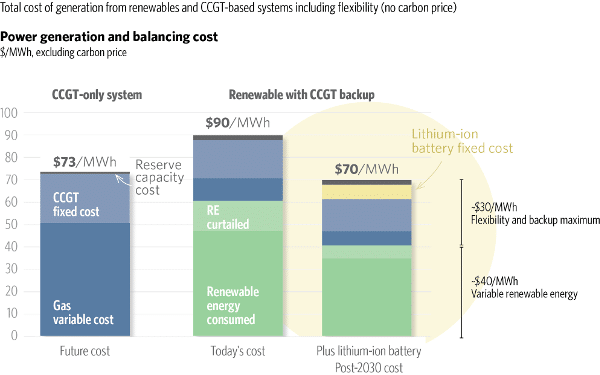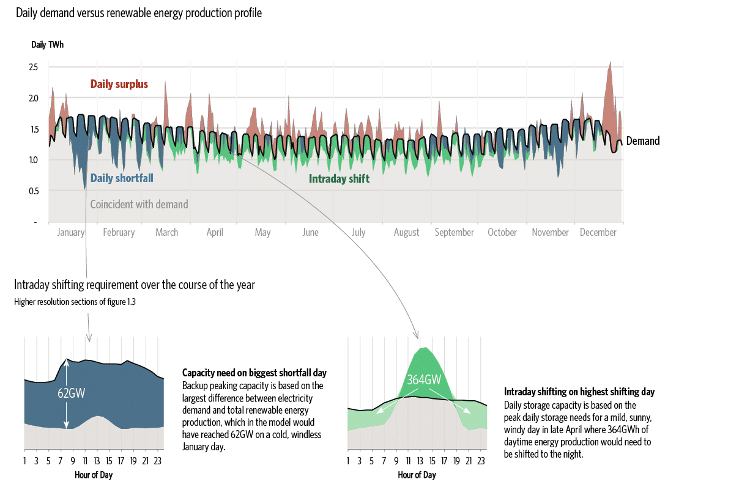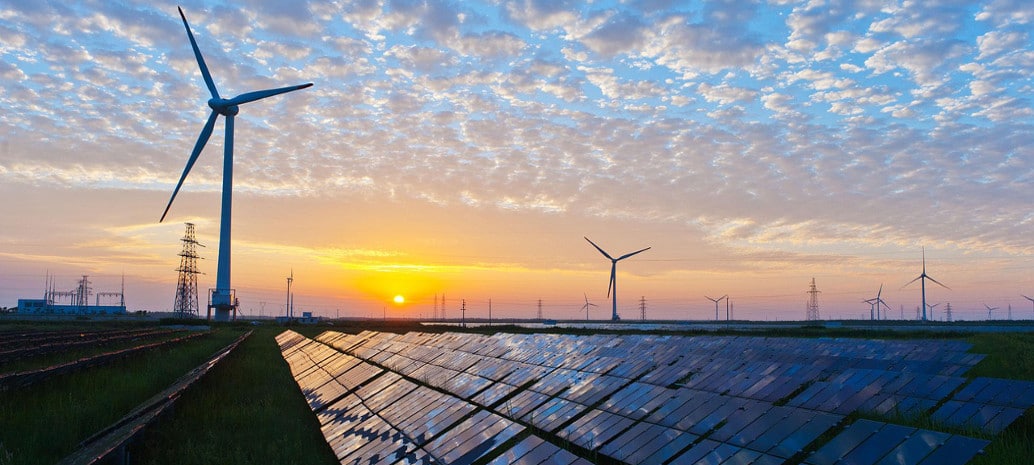Reliably supplying electricity to nations with millions of residents using solar and wind is a new task in the 21st century. Since this has never been done before, many details of how large electric grids will incorporate large volumes of wind and solar haven’t been clear. In essence, the electric power industry has been making the road while walking it.
In April, a new report was published by London’s Climate Policy Initiative (CPI) Energy Finance which charts a course for high penetrations of wind and solar on grids, looking specifically at four regions across the globe, including California. Flexibility: the path to low carbon, low cost grids also finds that by 2030, a system with “near-total” renewable energy generation and a mix of batteries and natural gas for backup “would be considerably less expensive than a system powered exclusively by natural gas”.
This is mostly due to the continued decline in costs for solar PV and wind generation, which are making these sources the least expensive forms of new generation. However, the report also relies on the ongoing declines in the cost of lithium-ion batteries.
These findings are part of a growing body of research that is showing that despite a fundamental rethinking of the electric grid that systems based on distributed and variable renewable energy require, such systems are not necessarily more expensive.
In 2014, the International Energy Agency (IEA) published Power of Transformation, a report that showed most nations could incorporate up to 45% wind and solar in their electric grids at limited additional cost, provided that proactive, system-wide planning was undertaken to optimize the grid for renewables.

But just as the pace of the Energy Transition has increased in recent years, CPI’s report goes well beyond the scenarios IEA envisioned three years ago. Flexibility instead looks at “near-total” renewable energy based systems, and finds that a “[m]ostly renewable with combined cycle gas turbine (CCGT) backup” system including lithium-ion battery deployment would cost $70 per megawatt-hour (MWh) after 2030. That is in contrast to the “future cost” of $73/MWh for a CCGT-only system – without accounting for any price on carbon.
This report runs at odds with both some of the campaigns that are being waged by renewable energy proponents and the current presidential administration.
Renewable energy fundamentalists will not be pleased that CPI’s vision for this near-total renewable energy system is a not a “100%” renewable energy system, as those planned in the work of Stanford University’s Mark Z. Jacobson and his Solutions Project are. As such, there is still a limited role for natural gas in geographies that do not possess hydropower generation, particularly during the winter to make up for lulls in wind generation.

However, instead of requiring a massive societal mobilization equal to the war effort in World War II, as Jacobson has alluded to, the system envisioned by Flexibility is essentially where our power system is moving today, with some advanced planning and policy tweaks.
And while this report was started well before the most recent election, Flexibility shows that the claim being pushed by the Trump Administration and particularly Energy Secretary Rick Perry that coal and nuclear “baseload” generation are necessary for a reliable electricity system is simply mythology.
“Electricity systems have always been managed ‘flexibly’,” notes the report. ”Weather, work patterns, industry, or even sports schedules create predictable or unexpected drops or spikes in demand. Sudden system failures, such as power station or transmission outages, mean that backup generation has always been required to keep the lights on.”
And while electric grids globally are moving in the direction of renewables and gas generation, CPI Energy warns that action needs to being now to optimize the grid for the upcoming changes.
“Policymakers need to begin significant changes to market and technology support now to ensure that low-cost flexibility is available in the future when it is needed,” states CPI in the report. “Even though many of the needs are several years in the future, developing and implementing new market designs and technological solutions will take time.”
If this is done, CPI says that technical issues such as are already being encountered in California can be mitigated.
If these market design, industry structure and technology development and implementation issues are addressed early, our analysis suggests that policymakers should be unconcerned about moving to levels of renewable energy deployment that are far higher than even the most ambitious plans in place today, including perhaps systems with nearly all energy generated by either reservoir hydro or variable renewable energy, where there is a moderate supply of hydroelectric supply available.
This content is protected by copyright and may not be reused. If you want to cooperate with us and would like to reuse some of our content, please contact: editors@pv-magazine.com.









By submitting this form you agree to pv magazine using your data for the purposes of publishing your comment.
Your personal data will only be disclosed or otherwise transmitted to third parties for the purposes of spam filtering or if this is necessary for technical maintenance of the website. Any other transfer to third parties will not take place unless this is justified on the basis of applicable data protection regulations or if pv magazine is legally obliged to do so.
You may revoke this consent at any time with effect for the future, in which case your personal data will be deleted immediately. Otherwise, your data will be deleted if pv magazine has processed your request or the purpose of data storage is fulfilled.
Further information on data privacy can be found in our Data Protection Policy.